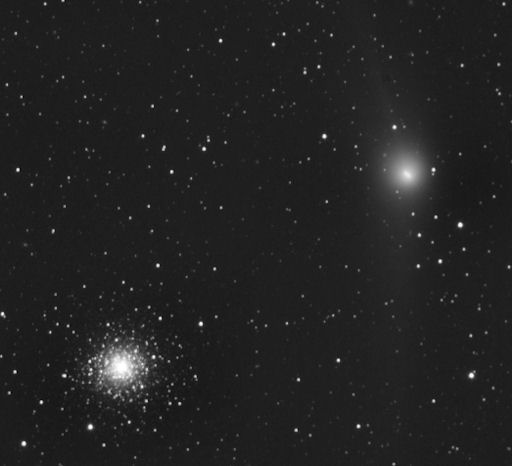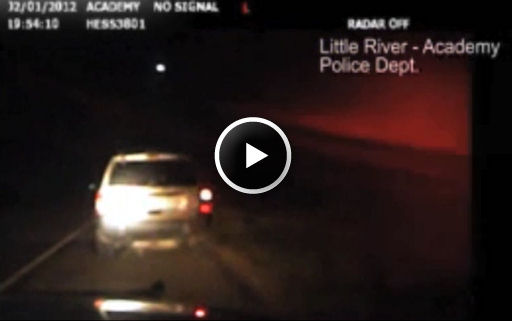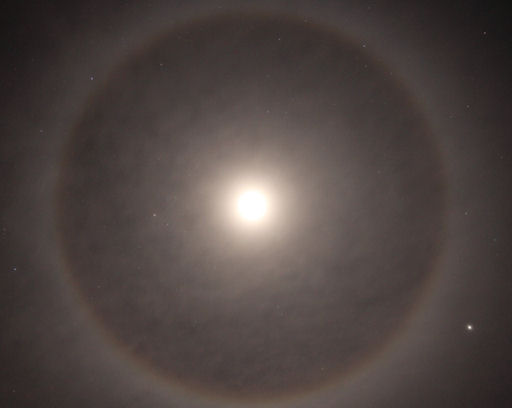QUIET SUN: Solar activity is very low. None of the sunspots on the Earthside of the sun is actively erupting, and NOAA forecasters estimate no more than a 1% chance of M-class flares during the next 24 hours. Solar flare alerts: text, voice.
COMET-CLUSTER CLOSE ENCOUNTER: This morning, February 3rd, Comet Garradd (C/2009 P1) sailed just 0.5 degrees from globular cluster M92 in Hercules. Amateur astronomer Philippe Roucheux photographed the pair from his backyard observatory in Joigny, France:
The star cluster and the comet are both located in the constellation Hercules, high overhead in northern hemisphere skies before sunrise. Although the comet is now receding from the cluster, observers with wide-field telescopes can frame the pair in a single exposure for several mornings to come. Sky and Telescope offers a sky map of the comet's path. Observers with computerized GOTO telescopes can track the comet by plugging in orbital elements from the Minor Planet Center.
At the moment, Comet Garradd has an astronomical magnitude of +6.5, invisible to the naked eye but an easy target for backyard telescopes. Forecasters expect it to brighten by a factor of ~2 in the weeks ahead as the comet approaches Earth for a 1.3 AU close encounter in early March. This could be a good time to invest in a Comet Hunter.
more images: from Gregg Ruppel of Ellisville, MO USA; from Jean Jacquinot of Aix en Provence, France; from Michael Kunze of Moers, Germany; from Dave Eagle of Higham Ferrers, UK; from Lorenzo Comolli of Bogli, Italy; from Gregg Ruppel of Ellisville, MO; from Mike Broussard of Maurice, Louisiana; from Dr Paolo Candy of Ci.A.O. Cimini Astronomical Observatory - Italy;
TEXAS FIREBALL: After nightfall on Feb. 1st, a spectacular fireball appeared in the skies of eastern Texas and Oklahoma. As is often the case for unexpected night-sky phenomena, few pictures are available. The best so far comes from a police dash-board camera in the small town of Little River-Academy, TX:
Eye-witness Daryn Morran reports: "At approximately 756pm CST, over Abilene, Texas, I saw an object falling from the sky much brighter and long-lasting than anything I've seen. [The fireball] lasted close to 8 secs before completely burning out. At first, it was bright white, and then started slowing down and getting brighter. Then it exploded like a firecracker artillery shell into several pieces, flickered a few more times and then slowly burned out... awesome!!!"
Another observer in Coppell, Texas, reported a "double boom heard at 8:00:30 CST. [The object appeared to be] 1/2 the size of the waxing moon, and broke into two major chucks with many smaller pieces. It had a 'white plasma' (sun-colored) look with a long golden tail." (This report was relayed by NWS meteorologist Joe Harrris in Frt Worth.)
According to Bill Cooke of NASA's Meteoroid Environment Office, this was probably a natural object--a small asteroid about the size of a car or bus--not a decaying satellite or other manmade space debris. The fireball, which disintegrated in the general vicinity of Dallas-Fort Worth, was bright enough to be seen on NASA cameras located in New Mexico more than 500 miles away. "It was about as bright as the full Moon (astronomical magnitude -13)," estimates Cooke, who is still analyzing data and sighting reports in hopes of calculating the object's orbit. He might yet figure out where the Texas fireball came from. Stay tuned for updates.
BE ALERT FOR MOON HALOES: With the full Moon less than a week away, now is the time to be alert for Moon haloes. Last night in Moray, Scotland, amateur astronomer Alan C. Tough photographed this specimen:
"I intended to photograph the Moon beside the Pleiades, but the cold and cloudy conditions were better suited to capturing this spectacular halo," says Tough.
Moon halos are formed by ice crystals in high clouds, which catch moonbeams and bend them as shown. The brighter the Moon, the brighter the Moon halo, so any halos this week should be very bright indeed. The Moon is full on Feb. 7th. Browse the links below for more examples of what's in store.
more images: from Jim Henderson of Kincardine O'Neil, Scotland; from Eric Walker of Conon Bridge, Ross-shire, Scotland; from Tyler Piskor of Karnes City, Texas;

![]()
Solar wind
speed: 421.6 km/sec
density: 2.1 protons/cm3
explanation | more data
Updated: Today at 1455 UT
![]()
X-ray Solar Flares
6-hr max: B3 0902 UT Feb03
24-hr: B7 0447 UT Feb03
explanation | more data
Updated: Today at: 1400 UT
![]()
![]()
![]()
Daily Sun: 03 Feb 12
![]()
![]()
All of the sunspots on the Earthside of the sun are quiet. Credit: SDO/HMI
![]()
![]()
![]()
Sunspot number: 85
What is the sunspot number?
Updated 02 Feb 2012
Spotless Days
Current Stretch: 0 days
2012 total: 0 days (0%)
2011 total: 2 days (<1%)
2010 total: 51 days (14%)
2009 total: 260 days (71%)
Since 2004: 821 days
Typical Solar Min: 486 days
Updated 02 Feb 2012
The Radio Sun
10.7 cm flux: 118 sfu
explanation | more data
Updated 02 Feb 2012
![]()
![]()
![]()
Current Auroral Oval:
![]()
Switch to: Europe, USA, New Zealand, Antarctica
Credit: NOAA/POES
![]()
![]()
![]()
Planetary K-index
Now: Kp= 2 quiet
24-hr max: Kp= 2 quiet
explanation | more data
![]()
Interplanetary Mag. Field
Btotal: 6.8 nT
Bz: 2.8 nT south
explanation | more data
Updated: Today at 1457 UT
![]()
![]()
![]()
Coronal Holes: 03 Feb 12
![]()
![]()
Solar wind flowing from the indicated coronal hole could reach Earth on Feb. 3-4. Credit: SDO/AIA. ![]()







